Exploring the Connection Between Heart and Brain
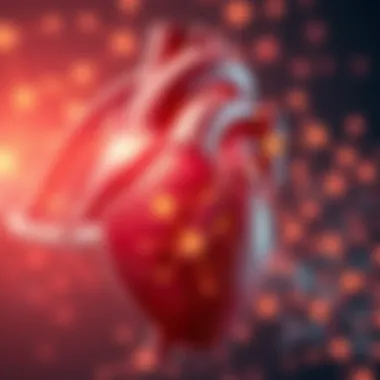
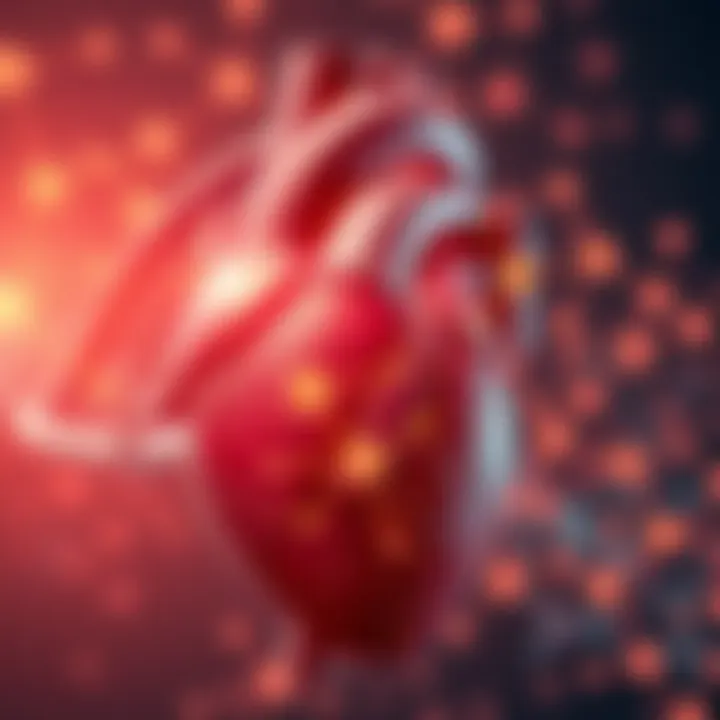
Intro
The connection between heart and brain transcends mere anatomical proximity. These two organs, often thought of in distinct contexts, share a complex interplay that significantly impacts our emotional landscape and overall well-being. While the heart pumps blood, sustaining life through its rhythmic beats, the brain processes thoughts and emotions, acting as the control center for human behavior. Understanding how these two vital systems communicate adds a layer of depth to the conversation around health and emotional balance.
Recent scientific studies showcase a fascinating blend of neurology and cardiology, revealing that the heart isn’t merely a pump—it's also capable of signaling emotional states. The waves of electrocardiogram signals produced by the heart can influence our thoughts, decisions, and feelings, presenting a compelling case for the synergy between these essential organs.
As we dive deeper into this discussion, we will explore multiple dimensions of the heart-brain relationship. This will include a look into the biochemical pathways that connect the two, the implications of their interactions on mental health, and how disruptions in this dialogue can lead to various health issues. By painting a comprehensive picture of this interplay, we aim to shed light on the importance of treating heart and mental health as interconnected elements for a holistic approach to wellness.
The ensuing sections will offer a systematic inquiry into recent discoveries, methodologies applied in research, and the broader implications for both healthcare practitioners and patients alike.
The Anatomy of the Heart and Brain
Understanding the anatomy of the heart and brain is essential in grasping how these two organs interplay within the human body. While they may seem like separate entities, their structures and functions are deeply intertwined, influencing both physical and emotional well-being.
The heart, often romanticized as the seat of emotion, is not merely a muscular pump; it represents a complex system of chambers and valves that facilitate blood circulation. Blood flow isn't just about nourishment for the body, but it also affects brain function and mood stability. Complications in heart structure can ripple through to neurological health, underscoring the need for a detailed exploration of both.
On the flip side, the brain acts as the control center of the body, orchestrating various physiological responses. Its structure houses intricate networks of neurons that define our cognition and emotional experiences. Understanding how brain structure communicates with heart function can lead to insights into conditions that intertwine cognitive decline with cardiovascular issues.
Heart Structure
The heart consists of four main chambers: the right atrium, right ventricle, left atrium, and left ventricle. These chambers work in a seamless cycle:
- Right Atrium: Collects deoxygenated blood from the body.
- Right Ventricle: Pumps blood to the lungs for oxygenation.
- Left Atrium: Receives oxygen-rich blood from the lungs.
- Left Ventricle: Distributes oxygenated blood to the rest of the body.
Moreover, the heart contains valves that prevent backflow, ensuring blood travels in a single, forward direction. The coronary arteries supply the heart muscle with the necessary oxygen, highlighting how heart structure fulfills both mechanical and metabolic needs. This delicate architecture is crucial, as any anomalies can amplify risks for both heart disease and brain dysfunction.
Brain Structure
The brain can be viewed as a labyrinth of complex networks. It has various components, but let’s consider a few key areas:
- Cerebrum: Responsible for higher brain functions such as thought, action, and emotion.
- Cerebellum: Coordinates movement and balance, enhancing physical activity.
- Brainstem: Oversees basic life functions like heart rate and breathing.
Neurons, the brain's signaling units, facilitate communication within the brain and between the brain and body. Synapses, the points of communication between neurons, play a critical role in how the brain influences heart rate and blood pressure. The intimate relationship between these structures becomes clear: structural or functional impairments in the brain can directly affect cardiovascular health.
Comparative Analysis
When looking at the anatomy of the heart and brain, both share the characteristic of being multi-layered systems that rely on interconnected functions. Although they have distinct roles, their structures mirror one another in that they are both designed to transmit signals and sustain life. In essence, a hiccup in one can easily lead to mischief in the other.
For instance, studies show that conditions such as hypertension can affect cognitive function and lead to neurodegenerative diseases. Likewise, cardiac events like heart attacks can trigger anxiety and depression – a clear sign of their partnership.
"The synergy between heart and brain reflects the very essence of human existence; when one falters, the other responds."
In summary, the interplay between the heart and brain starts with their anatomy. Their structures, though varied, link them through shared pathways of influence and communication, making this understanding vital in the broader conversation about health.
Physiological Functions
The interaction between the heart and brain forms a complex dance that is crucial for overall physical well-being. Understanding this interplay helps illuminate not just how these organs operate individually, but also how they rely on one another for optimal functionality. This section dives deeper into the physiological functions, specifically highlighting the cardiovascular and neurological functions—two key aspects that underscore their mutual reliance.
Cardiovascular Function
The heart serves as the body's engine, pumping blood that carries essential nutrients and oxygen to the cells, while also removing waste products. Its rhythmic contractions are not just important for sustaining life—they also play a significant role in influencing brain function. When the heart pumps blood, it generates a pressure wave that travels through the arteries to the brain.
However, the heart does more than just act as a pump. It releases hormones like atrial natriuretic peptide (ANP), which helps regulate blood pressure and fluid balance. These hormones can influence how the brain processes information, impacting mood and cognitive function.
Additionally, the state of one's cardiovascular health deeply intersects with brain health. High blood pressure or heart disease can lead to reduced blood flow to the brain, triggering cognitive decline over time. This might manifest as forgetfulness or difficulty concentrating—an often-overlooked warning sign that may indicate more than just a lack of focus.
**"An unsteady heartbeat can send shockwaves through the mind, reminding us that the heart's health is a lifeline to our brain's vitality."
A few key points regarding cardiovascular function include:
- Oxygen Supply: Adequate blood flow ensures neurons receive enough oxygen to function.
- Nutrient Delivery: Blood carries glucose and other nutrients necessary for brain metabolism.
- Waste Removal: Effective circulation helps clear toxins that could damage brain cells.
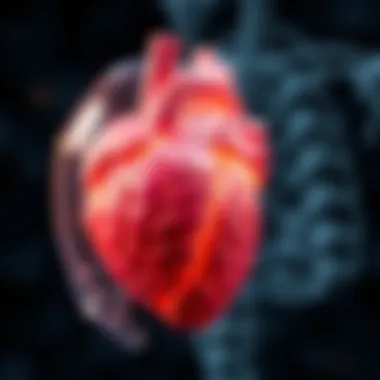
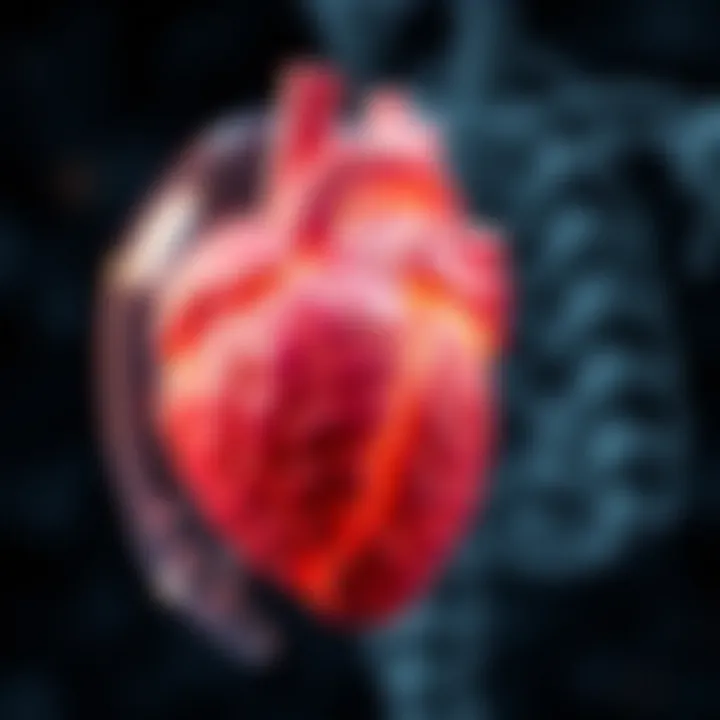
Neurological Function
While the heart is the powerhouse for circulation, the brain is the command center, orchestrating bodily functions and complex calculations based on information it receives. The neurological function is intimately tied to the physiological state of the heart. For instance, when one experiences stress or anxiety—which often manifests as an increased heart rate—the brain sends signals to release stress hormones like cortisol.
Cortisol is well-known for its role in the stress response, but its prolonged elevation can have detrimental effects on the brain. Chronic stress is linked to conditions such as depression and anxiety, which can lead to further cardiovascular strain. Here, we begin to see a loop: the heart's health can impact brain health, and vice versa, forming a cycle that emphasizes the importance of balance.
Several essential components in neurological function include:
- Signal Transmission: Neurons rely on electrolytes, often influenced by blood flow and cardiovascular health, to effectively transmit signals.
- Brain Waves: The heart's rhythm can synchronize with brain wave patterns, affecting cognitive states such as focus or relaxation.
- Emotional Processing: A healthy heart can facilitate better emotional management by ensuring the brain is adequately nourished.
Thus, the heart and brain interact through a two-way street where each organ informs and supports the other's functions. Understanding these physiological functions provides valuable insights into how one might influence the other, spawning discussions around preventative health measures and the importance of maintaining both cardiac and neurological health.
Communication Pathways
Understanding the communication pathways between the heart and the brain is essential to grasping their intricate interplay. This topic shines a spotlight on how these organs signal to one another, revealing how deeply intertwined their functions are. With research growing in this field, recognizing these pathways advances not only our knowledge of physiology but also informs clinical practices that can benefit mental and physical health. Here are some key elements to consider:
- Neural signals: The brain sends direct signals to the heart, modulating heart rate and blood pressure. This neural communication can alter cardiac function in response to stress or calmness.
- Hormonal responses: Hormones not only influence emotions but also affect heart function. For instance, stress hormones can increase heart rate, showcasing a more dynamic relationship beyond mere structural considerations.
- Bi-directional communication: The interaction is two-way. The heart speaks to the brain, too. This exchange impacts mood and cognition, demonstrating that mental health can be linked to cardiac status.
These pathways underline the potential for integrative therapies that take both the mind and heart into account. For instance, meditation, which calms the mind, may improve heart health.
"The brain does not only think; it feels. The heart does not merely pump; it communicates."
Neural Connections
Neural connections establish a direct line of communication between the heart and the brain. Nerve fibers, particularly from the vagus nerve, serve as a major route for this connection and play a critical role in controlling the heartbeat while also linking various brain centers that influence emotional responses. When you feel anxious, the brain sends signals that may increase heart rate, whereas calmness leads to a slower heartbeat. These neural pathways underscore how emotional states can manifest through physiological responses.
A greater understanding of these neural connections can lead to advancements in therapies for both heart and mental health. This is considered especially critical in stress management plans, where patients often experience both anxiety and cardiac symptoms concurrently.
Biochemical Signaling
Biochemical signaling is another vital area exploring how the heart and brain connect. It's about the chemistry that flows between these two pivotal organs. For example, when the heart produces certain hormones like atrial natriuretic peptide, it not only aids in managing blood pressure and fluid balance, but also sends information to the brain, influencing how emotions are perceived.
Conversely, neurotransmitters such as serotonin and dopamine, commonly associated with mood regulation, also affect cardiac function. Here’s a closer look at some key points regarding these signaling pathways:
- Hormonal impact: The heart releases hormones that can influence stress responses in the brain. High levels of stress hormones, like cortisol, can lead to detrimental effects on both brain and heart health.
- Feedback mechanisms: The exchanges create feedback loops. For example, chronic stress can lead to heart problems, which in turn may exacerbate mental health issues, creating a cycle that can be hard to break.
Overall, the significance of biochemical signaling can’t be overstated. It’s not merely about the electrical impulses; it’s about the entire chemical interplay that keeps our emotions, thoughts, and cardiovascular systems in sync. To truly treat an individual, one must consider the heart-brain connection.
Emotional Connections
Impact on Emotion Regulation
The regulation of emotions plays a crucial role in mental health, yet it often comes underappreciated in ordinary discussions. When emotions arise, the heart responds rapidly—its rhythm changes, blood pressure might spike, and one can feel that familiar flutter. These physiological changes are not mere coincidence; they are part of a larger system of communication between the two organs.
For example, during times of happiness or excitement, a person's heartbeat often quickens, serving as an external indicator of internal emotional states. On the other hand, stress and anxiety can lead to irregular heartbeats or palpitations, revealing how deeply intertwined our feelings are with our cardiac function. Here are some key points highlighting this connection:
- Sympathetic Activation: When a person feels stressed, the sympathetic nervous system kicks in, influencing heart rate and, in turn, affecting emotional perception.
- Feedback Loop: The heart can send signals to the brain that can amplify feelings of anxiety or joy, creating a feedback loop that influences how we regulate our emotions.
- Therapeutic Implications: Awareness of this connection can be instrumental in therapeutic settings, where understanding how the heart reacts to different emotional stimuli can inform treatment plans for mental health.
The Role of Stress
Stress is often portrayed as the villain in our emotional landscape, but it also has its nuances. In moderation, stress can serve as a motivating factor; however, chronic stress poses significant risks to both the heart and the brain. The physiological impact of prolonged stress leads to a cascade of issues, not only in emotional regulation but also in cardiovascular health.
The relationship between stress and health can be illustrated through the following aspects:
- Cortisol Surge: Stress triggers the release of cortisol, a hormone that, when in excess, can result in a range of health issues including hypertension and impaired cognitive function.
- Emotional Exhaustion: Unmanaged stress can leave individuals feeling emotionally drained, making it harder to cope with everyday challenges.
- Social Support: Having strong relationships can buffer the effects of stress by modulating both heart rate and emotional response, revealing the power of community and social bonding.
The way that stress affects heart and brain interactions emphasizes the need for effective stress management techniques, such as mindfulness or cognitive-behavioral therapy.
Psychosomatic Interactions
The intricate relationship between our thoughts and our physical health plays a critical role in understanding how the heart and brain operate in sync. This section highlights psychosomatic interactions, emphasizing that mental processes significantly influence physical health outcomes.
Influence of Thoughts on Health
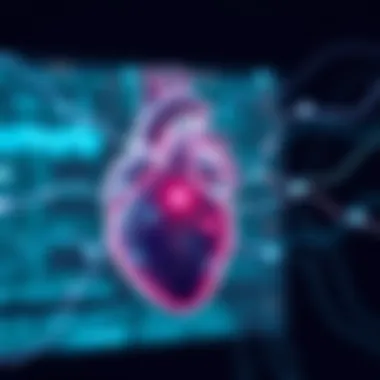
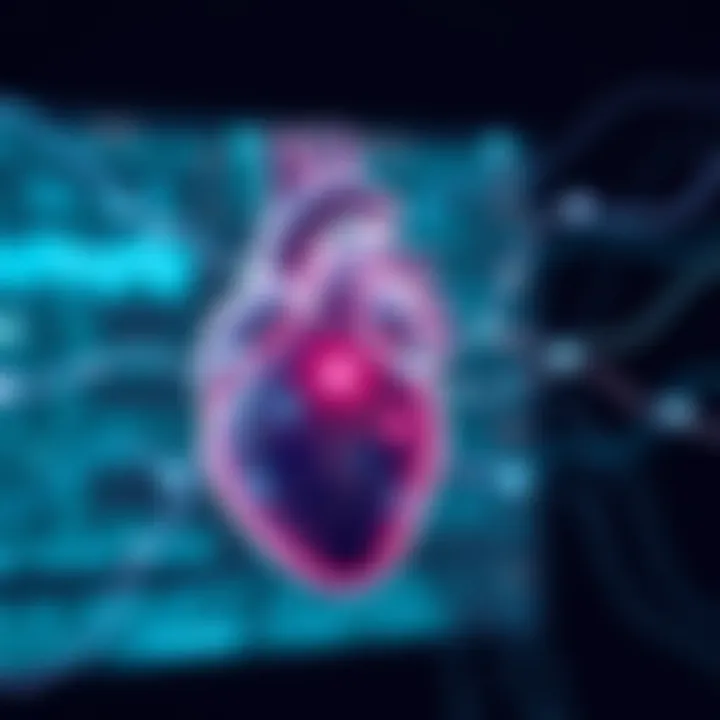
Thoughts, whether positive or negative, can deeply affect our overall health. Research has shown that a calm and positive mindset can lower blood pressure and reduce heart rate, while anxiety and negative thinking can lead to increased stress responses. For instance, individuals with a history of depression often face a higher risk of cardiovascular diseases. This link suggests that our mental state has a tangible impact on physiological health.
- Claims from Studies:
- A noteworthy study published in the Journal of Psychosomatic Research indicates that positive emotions correlate with lower incidence of heart-related issues.
- The American Heart Association highlights stress management as crucial for heart disease prevention.
To put it another way, your heart can feel the weight of your worries. It's important to acknowledge that lifestyle choices, such as mindfulness practices, can enhance emotional resilience and consequently affect heart health. This creates an engaging loop where the decision to adopt healthier thoughts can lead to improved physical well-being.
Physical Reactions to Emotions
When emotional states escalate, they trigger physiological responses that can affect the heart significantly. Consider the common expressions like "my heart sank" or "feel my heart racing"; they illustrate how intertwined these systems are. Emotions like fear or joy can lead to distinct heart responses:
- Fight or Flight Reaction:
- Joy and Relaxation:
- Heightened stress from fear prompts adrenaline release, increasing heart rate and blood pressure—preparing the body for immediate action.
- Positive feelings can induce a calming effect, slowing the heart rate, and decreasing blood pressure.
The body absorbs the environment through emotions; the heart often becomes an unwitting participant in this dialogue.
In evaluating physical reactions to emotions, a holistic approach to health often arises. Integrating practices that address both mental and emotional well-being, such as yoga or meditation, can be beneficial. These practices not only soothe the mind but also promote cardiovascular health. The implication is clear: fostering emotional intelligence is not just a matter of mental wellness, but a vital aspect for maintaining a healthy heart.
Pathological Insights
Understanding the link between heart and brain is not just a matter of anatomy; it carries significant implications for health. The relationship impacts both organs' functioning, particularly in the context of diseases. Here, we delve deeper into how diseases affecting the heart can often intertwine with mental health issues, creating a cycle that can exacerbate suffering and complicate treatment. Our examination goes beyond mere statistics; it sheds light on the underlying connections that can be seen in both psychological disorders and cardiovascular instability.
Heart Disease and Mental Health
Heart disease is increasingly recognized as a condition with psychological ramifications. Research points to a two-way street: individuals with heart conditions often display a higher prevalence of anxiety and depression.
- Causative Factors: Chronic illnesses like heart disease can lead to feelings of hopelessness or fear, influencing patients' mental states. Moreover, certain lifestyle choices made as a reaction to heart health concerns—such as reduced physical activity or altered diet—can further exacerbate depressive symptoms.
- Treatment Considerations: Leaving mental health unaddressed in patients with heart disease is akin to ignoring half the picture. When therapies do not incorporate counseling or psychological support, recovery may stall, leaving patients feeling disillusioned.
- Emotional Resilience: Strategies that focus on building emotional resilience—like cognitive behavioral therapy (CBT)—have shown promise in breaking this cycle. These methods empower individuals to cope more effectively with their heart disease, promoting overall well-being.
"To address heart disease effectively, we must also address the mental health challenges that accompany it; they are, in many ways, two sides of the same coin."
Neurological Disorders and Cardiovascular Risk
The interplay between neurological disorders and cardiovascular health is complex. Conditions such as stroke and epilepsy not only affect the brain but can have serious implications for heart health as well.
- Interconnected Risks: Individuals suffering from neurological disorders often face increased cardiovascular risks. For example, a stroke can lead to changes in the body that contribute to heart problems, creating an intricate web of vulnerability.
- Regulation Breakdown: Neurological conditions can disrupt the autonomic nervous system, which plays a crucial role in regulating heart function. This disruption can increase heart rates and introduce arrhythmias, posing significant health risks.
- Preventative Strategies: Monitoring cardiovascular health should be a priority for individuals experiencing neurological issues. Regular check-ups, lifestyle modifications, and awareness of symptoms can help in mitigating these risks.
In sum, acknowledging the profound interactions between neurological disorders and heart health can improve treatment outcomes and promote holistic care strategies, necessitating a collaborative approach to patient management.
Implications for Treatment
Recent studies indicate that aligning treatments that consider both heart and brain mechanics can enhance therapeutic effectiveness. Having a combined approach can bring about substantial benefits, such as optimizing recovery after cardiac events or managing chronic neurological disorders.
This article will delve into how this integration is essential, primarily focusing on two vital components:
- Integrative Approaches
- Mind-Body Therapies
In the next subsections, we will explore how these methods can bridge any gaps in traditional treatments, emphasizing the multi-dimensional benefits of considering the heart-brain connection. By adopting a holistic view, practitioners can design treatment plans that cater to both physiological and psychological aspects of health, ensuring a well-rounded recovery process.
Integrative Approaches
Integrative approaches encompass various strategies that unite conventional medicine with complementary therapies aimed at patients' overall health. This way of treating acknowledges the complex connections between the heart and the brain. For instance, lifestyle interventions that prioritize nutrition, exercise, and stress reduction can significantly impact both cardiovascular and brain health.
Some elements to consider in integrative approaches include:
- Nutrition: Diets rich in antioxidants, omega-3 fatty acids, and low in processed sugars can simultaneously enhance heart health and cognitive functions.
- Physical Activity: Engaging in consistent, moderate exercise benefits heart function as well as releases endorphins, contributing to emotional stability.
- Stress Management: Practices such as yoga and mindfulness can lower cortisol levels, offering relief not only to the heart but also calming the mind.
"Exploring integrative approaches to health is like fitting pieces of a puzzle together—each piece matters and complements the other."
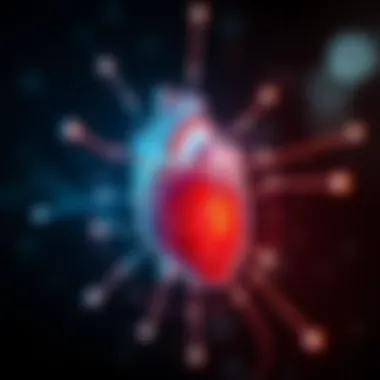
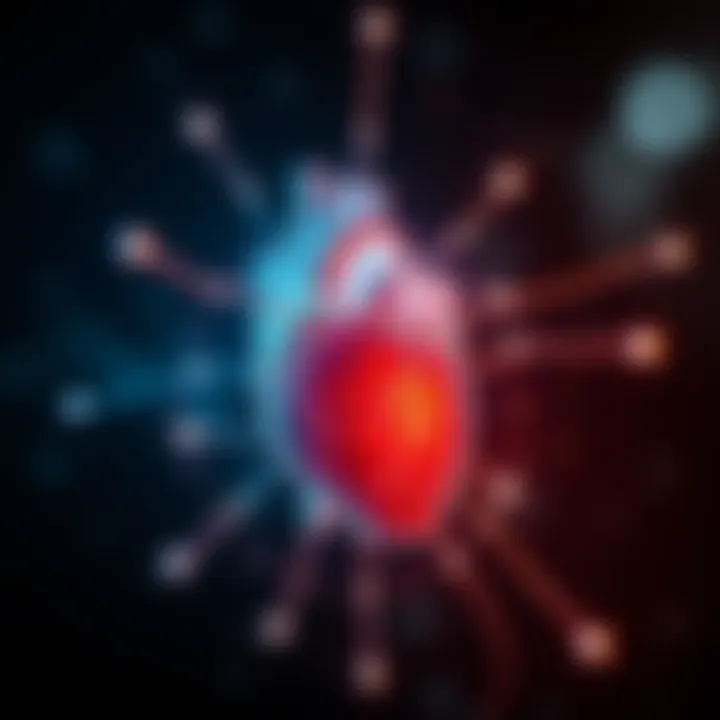
These methods not only work toward preventing disease but also foster an environment in which healing can take place. By understanding these connections, healthcare providers can tailor therapies that address both dimensions, leading to improved patient outcomes.
Mind-Body Therapies
Mind-body therapies have gained traction as pivotal components in dealing with the multifaceted nature of health. These therapies focus on the direct relationship between mental processes and physical outcomes, forging a therapeutic space where the heart and brain can be addressed simultaneously.
Some widely recognized mind-body therapies with evident potential include:
- Meditation: Regular practice can decrease stress and anxiety, contributing positively to heart health by lowering blood pressure and heart rate.
- Biofeedback: By using real-time feedback on physiological functions, individuals can learn to control bodily processes that relate to anxiety and stress, positively impacting cardiac health.
- Tai Chi and Qigong: These gentle movements not only improve balance and flexibility but can also enhance emotional well-being and cardiovascular fitness.
Engaging in these therapies fosters a genuine connection between heart and mind, promoting mental clarity alongside physical vitality. The tailored application of these mind-body therapies can empower patients, giving them agency over their health and well-being. The journey toward understanding these treatments is significant not only for the practitioners but also greatly enhances patient experience and outcomes.
Cultural Perspectives
The study of how the heart and brain interplay isn't just a scientific endeavor; it's woven into the fabric of cultures worldwide. Exploring cultural perspectives on this connection can enhance our understanding of the emotional, psychological, and societal implications that arise from how these two vital organs influence each other. It invites introspection about how various cultures interpret love, wisdom, and sentience—an interplay that magnifies the importance of recognizing that our physiological functions are not isolated but rather intertwined within a larger social context.
For instance, different cultures attribute various meanings to the heart and brain. In many Western traditions, the heart symbolizes love and emotional depth, while the brain often aligns with intellect and reason. This dichotomy sets the stage for a tension between emotional responses and analytical thought, illuminating how societies prioritize different forms of human experience. Conversely, in some Eastern philosophies, such as in certain interpretations of Buddhism and Confucianism, there's a harmonious view that integrates both emotional intelligence and cognitive reasoning, showcasing an ideal balance—a synthesis of the heart and the brain.
Thus, cultural perspectives not only celebrate diversity in thought and belief, but they also encourage us to reconsider the conventional binaries we frequently encounter. They remind us that our connects to emotions and cognitive processes vary widely, shaped through the lenses of cultural narratives, traditions, and biases.
Historical Views on Heart and Brain Functions
Historically, the heart has often been hailed as the seat of emotion and consciousness. In ancient Egypt, it was believed that the heart was weighed against a feather after death to determine one's fate, suggesting that emotions and moral choices were of utmost significance. The Greeks too, particularly philosophers like Aristotle, placed great emphasis on the heart as the source of intelligence and identity. They believed it was the location for thinking, rather than the brain. This antiquated notion begs an inquiry into how perceptions of these organs have influenced societal understandings of emotional and cognitive health over centuries.
In contrast, as we moved into the Enlightenment and later eras, the brain found its footing as the center of rational thought. With the advances in neuroscience during the 19th and 20th centuries, scientists began to unravel the complex functions of the brain, shifting the focus away from the heart. This shift signified not only a change in scientific understanding but also reflected how human beings began to categorize emotions and intellect into more defined compartments.
The historical views show a fascinating progression from a dualistic approach—where the heart and brain were seen as co-partners in the human experience—to a more brain-centered understanding predominant today. However, this shift, while illuminating, has not erased the deeply ingrained symbolic resonance of the heart in cultural thought. It reminds us of the continued struggle to find balance in recognizing both emotional and cognitive processes as essential to human functioning.
Symbolism and Metaphor in Art and Literature
Art and literature have long served as reflections of society’s understanding of the human condition, intertwining the heart and brain in poignant ways. From Shakespeare’s sonnets that explore love through the lens of emotional turmoil to scientific texts delving into the complexities of neurological functions, the metaphorical landscape is rich and varied.
Take, for instance, the pervasive imagery of the heart in literature. It often portrays themes of love, loss, and vulnerability, signifying its role as a symbol of emotional experience. Authors like Emily Dickinson or Pablo Neruda weave the heart into their works, presenting it as both fragile and resilient, capturing the essence of human emotion.
On the other hand, the brain often finds itself represented as a maze or a complex cityscape in artistic expressions. This highlights the convoluted nature of thought, consciousness, and decision-making. In modern literature, this duality conveys a fusion rather than a conflict of emotion and intellect. It sparks conversations around mental health and the societal pressures surrounding cognitive expectations, fostering a holistic narrative around understanding human psychology.
Interestingly, modern art from the likes of Frida Kahlo intertwines these symbols, illustrating emotional pain through vivid representations that resonate with both heart and mind. The blending of these two motifs in art not only emphasizes their interconnectedness but also invites deeper discussions on mental health, emotional awareness, and the need for balance in a fast-paced world.
In summary, cultural perspectives on the heart and brain reveal vast landscapes of meaning while propelling us to think critically about our emotional and cognitive experiences. Historical views portray the evolution of beliefs that shaped our understanding, while rich artistic expressions continue to explore and reflect the complexities of human life. By acknowledging these layers, we enhance our comprehension of the heart-brain interplay, making it not just a scientific inquiry but a profoundly human one.
Future Research Directions
The exploration of the relationship between the heart and brain has gained increasing attention in recent years. Understanding this interplay is pivotal, not just for theoretical insight but also for practical health applications. As researchers delve into this profound connection, several future research directions emerge, paving the way for innovative approaches to health and wellness.
Importance of Future Research Directions
The significance of investigating future directions in this area cannot be overstated. Much of what we know today about the heart-brain connection is still in its infancy. There remains a wealth of insight waiting to be uncovered about how emotions influence cardiovascular health and vice versa. Here are a few considerations regarding the importance of these explorations:
- Optimizing Mental and Physical Health: By gaining a clearer understanding of these connections, we can improve treatment strategies for conditions like depression, anxiety, cardiovascular diseases, and stress-related disorders.
- Identifying Risk Factors: Studies that focus on the heart-brain interactions may reveal hidden risk factors for both mental and physical illnesses, leading to better preventive measures.
- Enhancing Therapeutic Modalities: Insights gained may inspire new therapies that are integrative, catering to both emotional and cardiovascular health.
Emerging Technologies in Neuroscience
Advancements in technology play a crucial role in pushing the boundaries of knowledge within neuroscience. Sophisticated tools and methodologies are being developed to illuminate how heart and brain activities interconnect. Several key technologies are making waves in this research area:
- Functional MRI (fMRI): This imaging technique allows researchers to observe brain activity in real-time, providing insights into how emotional processes affect heart rate and blood flow.
- Wearable Biometric Devices: Modern gadgets can track heart rate variability and mood indicators, offering a longitudinal view of how heart function correlates with mental states.
- Electrophysiological Monitoring: Devices that sense electrical activity in the heart and brain can help scientists understand the timing and nature of their interactions during different emotional responses.
These technologies not only enhance data collection but also improve the validity and reliability of findings, which are essential for scientific progress.
The Role of Artificial Intelligence in Understanding the Heart-Brain Connection
Artificial intelligence (AI) holds immense potential to deepen our knowledge about the relationship between the heart and the brain. By analyzing vast datasets, AI can uncover patterns and subtleties that human researchers might miss. Some implications of AI in this arena include:
- Data Analysis and Prediction: Machine learning algorithms can identify trends and predict outcomes based on various inputs like heart rhythms and emotional states. This predictive power can optimize interventions.
- Personalized Medicine: AI’s ability to analyze individual health data may lead to tailored treatment regimens that address both heart and brain health simultaneously, improving patient outcomes.
- Research Efficiency: Automation of data collection and processing can significantly reduce the time required to conduct studies, allowing for quicker trials and more rapid advancements.
By pursuing these research avenues, we edge closer to a more integrated understanding of human physiology, which can lead to innovative treatments and a better quality of life. > "Advancements in technology and AI have the potential to revolutionize our understanding of the heart-brain dynamic, paving the way for new paradigms in health care."
Ultimately, the intricate interplay between the heart and brain remains an enigmatic realm of study. However, with ongoing technological advancement and innovative methodologies, future research is set to offer deeper insights that could transform how we approach health, treatment, and overall well-being.
Learn more about neuroscience technologies at Britannica and explore heart-health info at CDC.gov.







